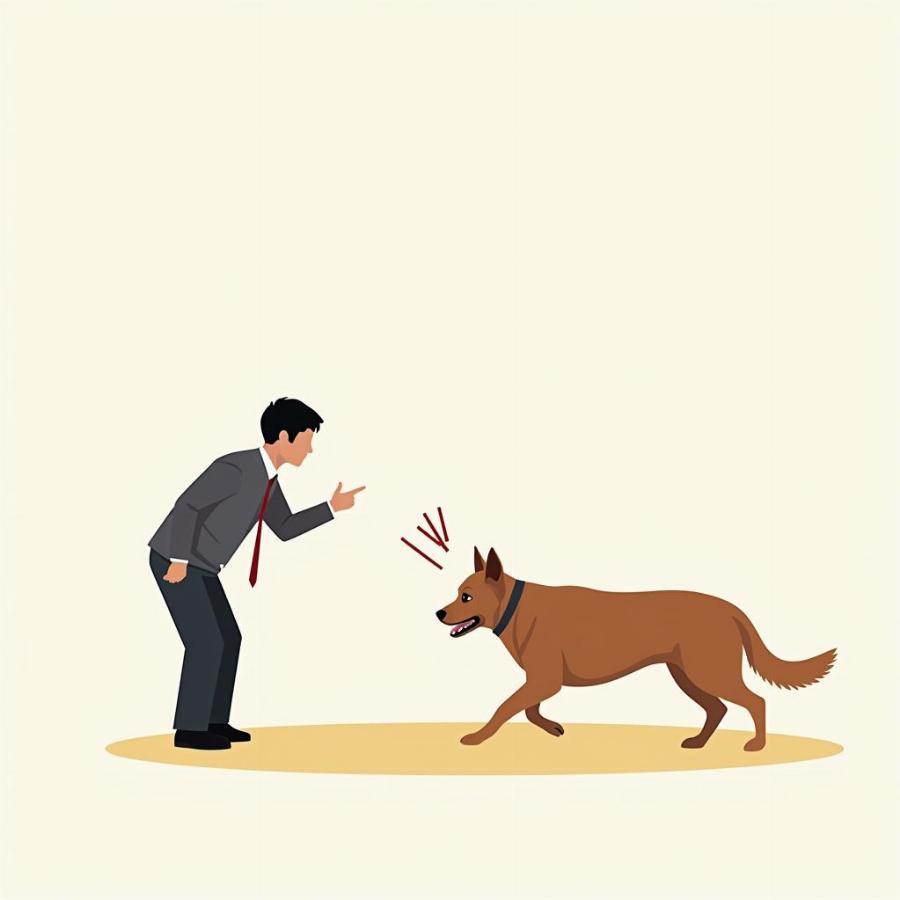The term “mad dog” often conjures up images of a foaming-at-the-mouth, wildly aggressive animal. While thankfully rare, true rabies infection can cause this type of behavior. However, most of the time, when we talk about a “mad dog,” we’re referring to aggression stemming from other, often preventable, causes. Understanding these causes is crucial for responsible dog ownership and can help keep both pets and people safe.
Decoding Canine Aggression: It’s Not Always What It Seems
Dogs use aggression as a way to communicate, often when they feel threatened, scared, or stressed. Unlike humans who primarily use verbal communication, a dog’s “language” relies heavily on body language and vocalizations. What might seem like a sudden, unprovoked outburst could be a dog’s way of saying, “I’m uncomfortable,” “Stay away,” or “I need space.”
Here are some key points to remember about canine aggression:
- It’s rarely out of nowhere: Almost all aggression has an underlying trigger. Identifying those triggers is crucial to managing and modifying the behavior.
- Breed alone is not a predictor: While certain breeds might be predisposed to certain temperaments, every dog is an individual. Proper socialization, training, and responsible breeding practices play a significant role in a dog’s behavior.
- Fear is a major factor: Many aggressive displays stem from fear or anxiety. A dog might lash out if it feels trapped, cornered, or threatened in any way.
Common Triggers: What Makes a Dog See Red?
Understanding the common triggers of aggression can help owners prevent dangerous situations. Here are some of the most prevalent causes:
- Resource Guarding: This occurs when a dog becomes possessive over food, toys, a specific location, or even a person.
- Territorial Behavior: Dogs are naturally territorial and might display aggression towards strangers entering their perceived territory (home, yard, etc.).
- Pain or Illness: A dog in pain or suffering from a medical condition might behave aggressively, especially if touched in a sensitive area.
- Maternal Instincts: Mother dogs can be highly protective of their puppies and might react aggressively to perceived threats.
- Past Trauma: Dogs with a history of abuse or neglect might exhibit fear-based aggression as a defense mechanism.
What to Do (and Not Do) When Facing Canine Aggression
Encountering an aggressive dog can be frightening. Here’s a quick guide on how to react:
DO:
- Stay Calm: Avoid screaming or sudden movements, as this can escalate the situation.
- Give the Dog Space: Slowly create distance between yourself and the dog, allowing it an escape route if possible.
- Speak in a Calm, Soothing Voice: Avoid direct eye contact, as this can be perceived as a challenge.
DON’T:
- Run: This might trigger the dog’s prey drive and make them more likely to chase.
- Approach the Dog: Leave approaching or attempting to pet an unfamiliar dog to trained professionals.
- Punish the Dog: Physical punishment can increase fear and make the aggression worse.
 Reacting to a Dog's Aggression
Reacting to a Dog's Aggression
When to Seek Professional Help
If you are concerned about your dog’s behavior, or if they have displayed aggression in the past, it’s essential to seek professional help immediately. A certified professional dog trainer or veterinary behaviorist can assess your dog’s behavior, identify triggers, and develop a tailored behavior modification plan.
[hearthwood dog and cat]
Preventing Aggression: Setting Your Dog Up for Success
The good news is that many forms of aggression are preventable. Here are some key ways to help your dog become a well-adjusted canine citizen:
- Early Socialization: Expose your puppy to a variety of sights, sounds, people, and other dogs during the critical socialization period (up to 16 weeks of age).
- Positive Reinforcement Training: Use reward-based training methods to teach basic commands and desirable behaviors.
- Identify and Manage Triggers: If you know your dog is prone to resource guarding, for example, feed them in a separate location or provide high-value treats when people approach.
- Provide Mental and Physical Enrichment: A bored or under-stimulated dog is more likely to develop behavioral issues. Ensure your dog gets plenty of exercise, playtime, and mental stimulation.
Remember, a “mad dog” is rarely born; they are often made. By understanding canine behavior, providing proper socialization and training, and being aware of potential triggers, we can help our furry companions live happy, well-adjusted lives and create a safer environment for everyone.
FAQs About Dog Aggression
Q: Can an aggressive dog ever be cured?
A: While “cure” isn’t always the right word, with proper management, training, and professional intervention, many dogs can learn to manage their aggression and live safely and happily in homes.
Q: My dog has never shown aggression before, but recently snapped at someone. Should I be worried?
A: Any sudden change in behavior warrants a trip to the veterinarian. Pain, illness, or cognitive decline can sometimes manifest as aggression.
[rimadyl 100mg for dogs]
Q: I’m adopting an adult dog with a history of aggression. What should I expect?
A: Be prepared to work closely with a qualified professional trainer and manage the dog’s environment carefully. Patience, consistency, and a commitment to the training plan are crucial.
If you have any further questions or need support in understanding and managing canine aggression, the team at Beaut Dogs** is here to help. Contact us at [email protected] for personalized advice and resources.
Beaut Dogs is your trusted source for all things dog-related. We provide reliable and insightful information to help you navigate the world of dog ownership with confidence and care. Visit us today at https://beautdogs.com to learn more!